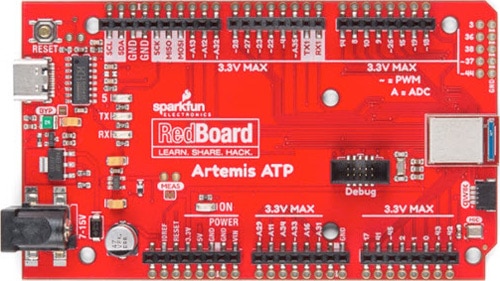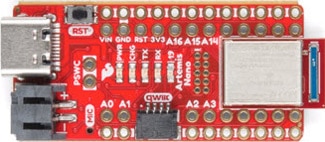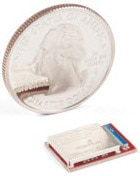Getting Started with AI using Sparkfuns Bluetooth Enabled Artemis Module
2019-08-28 | By Kevin Walseth
Today is a day that will always be remembered in the world of electronics enthusiasts. Sparkfun’s Artemis boards are now available for sale. These boards are more than just another Arduino for the lab. These are fully FCC certified boards that can take you from getting the on-board LED to blink thru running a full TensorFlow® Lite machine learning model. These boards all come with a modern USB-C connector. They also support the Sparkfun Qwiic® ecosystem to help unleash the creativeness with more than 70 sensors and accessories. No soldering required. Here are the four great options available.
The Redboard Artemis ATP – which is the footprint of an Arduino Mega. ATP stands for “All the Pins” at Sparkfun including 48 GPIOs that are all interrupt capable. The 1M of Flash memory and a blazing clock speed of 48 Mhz / 96MHz turbo allow you to use the Artemis module to its full potential.

The Redboard Artemis is in the form factor of an Arduino Uno, but don’t count out its capabilities. With BLE and one meg of flash you can run this powerhouse at an impressive 1mA. The RedBoard has the ability to run TensorFlow® lite models which can bring an all new element to your project with Machine Learning and AI. A ground-up rebuilt using the Arduino Core from Sparkfun has given this board the time-to-first-blink in less than 5 minutes.

Don’t forget about the Redboard Artemis Nano. It may be small and lightweight, but it is a complete party in the front and business in the back – Sparkfun’s joke about the Nano. This well-designed board is the same form factor as the Arduino Nano. All of the connectors, LEDs, Labels, and buttons are on the front. While the powerful Ambiq microcontroller and the rest of the circuitry is on the back.

The brain behind this awesomeness is the Sparkfun Artemis Module. This Low power Cortex-M4F with BLE 5.0 is the first module the help hobbyists as well as engineers designing for consumer goods. It is made to help prototype with the 3 development boards, then take this FCC certified module into production. What else could you ask for?

Here are the comparisons between the products:
| Module Capabilities | Nano | RedBoard | ATP | |
|---|---|---|---|---|
| Footprint | 10mm x 15mm | Arduino Nano | Arduino UNO | Arduino Mega |
| Certifications | FCC/IC/CE Certified | FCC/IC/CE Certified | FCC/IC/CE Certified | FCC/IC/CE Certified |
| Microcontroller | Ambiq Apollo 3 | Ambiq Apollo 3 | Ambiq Apollo 3 | Ambiq Apollo 3 |
| Processor | Cortex-M4F | Cortex-M4F | Cortex-M4F | Cortex-M4F |
| Memory | 1M Flash / 384k RAM | 1M Flash / 384k RAM | 1M Flash / 384k RAM | 1M Flash / 384k RAM |
| Speed | 48MHz / 96MHz turbo available | 48MHz / 96MHz turbo available | 48MHz / 96MHz turbo available | 48MHz / 96MHz turbo available |
| Power Consumption | 6uA / MHz (operates less than 5mW at full operation) | 6uA / MHz (operates less than 5mW at full operation) | 6uA / MHz (operates less than 5mW at full operation) | 6uA / MHz (operates less than 5mW at full operation) |
| Bluetooth | Built-in BLE radio and antenna | Built-in BLE 5.0 radio | Built-in BLE 5.0 radio | Built-in BLE 5.0 radio |
| GPIO | 48 GPIO - all interrupt capable | 19 GPIO - all interrupt capable | 24 GPIO - all interrupt capable | 48 GPIO - all interrupt capable |
| PWM | 31 PWM channels | 17 PWM channels | 21 PWM channels | 31 PWM channels |
| ADC | 10 ADC channels with 14-bit precision with up to 2.67 million samples per second effective continuous, multi-slot sampling rate | 8 ADC channels with 14-bit precision | 10 ADC channels with 14-bit precision | 10 ADC channels with 14-bit precision with up to 2.67 million samples per second effective continuous, multi-slot sampling rate |
| UART | 2 UARTs | 2 UARTs | 2 UARTs | 2 UARTs |
| I2C | 6 I2C buses | 4 I2C buses | 6 I2C buses | 6 I2C buses |
| SPI | 6 SPI buses | 2 SPI buses | 4 SPI buses | 6 SPI buses |
| PDM | PDM Interface | PDM Digital Microphone | PDM Interface | PDM Interface |
| I2S | I2S Interface | - | I2S Interface | I2S Interface |
| SPI | 2/4/8-bit SPI bus | - | - | 2/4/8-bit SPI bus |
| Smart Card | Secure 'Smart Card' interface | - | - | Secure 'Smart Card' interface |
| Expansion | - | Qwiic Connector | Qwiic Connector | Qwiic Connector |
This series of boards from Sparkfun has taken electronic design to the next level. Dabbling into Machine Learning is a lot of fun and is definitely the direction of the future.






